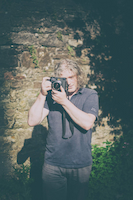Polarising filters are probably the most important filters in photography.
To understand when to use polarisers, it is important to understand reflectance.
Simply put, reflectance is defined as a "measure of the ability of a surface to reflect light or other electromagnetic radiation".
While the polariser hasn't changed the amount of light leaving the surface of the an object, in this case bracken on the hillside, it has remained the same - but the polariser has prevented some of that light from reaching the lens and sensor.
In this case, the striking green landscape of Ireland's Wicklow Mountains, we can easily see the difference between the polarised and non-polarised image.
In the non-polarised image, below, the bracken have part glossy leaves and many are angled towards the camera meaning that without a polarised the sensor is seeing bright light, not a problem in autumn and winter when the plants die back and give the hillsides a characteristic reddish-brown with little chance of reflectance.

As a result there is quite a bit of contrast in the image and very little colour is being recorded.
Whereas, looking at the polarised image below, the polarising filter has blocked some of that reflected sunlight shielding the sensor and allowing the colour information to be recorded as true - here it's the bright green that Wicklow is famous for.

See the effect of using a polariser on architecture and clear blue sky in this previous post: https://panoramicireland.com/photo-tours-blog/using-polarising-filters-photography-architecture

